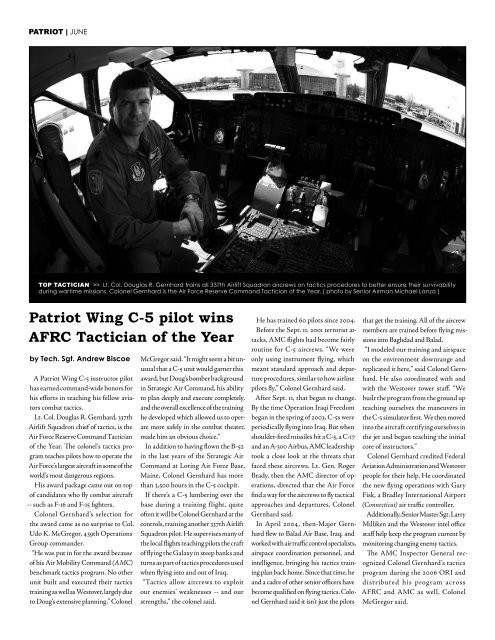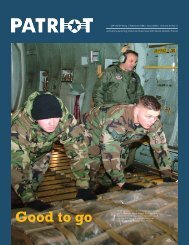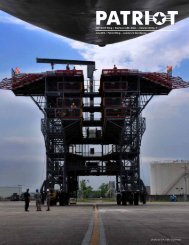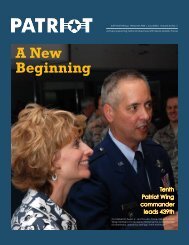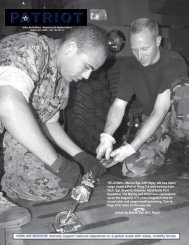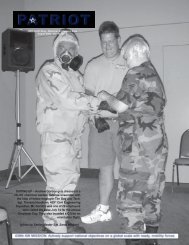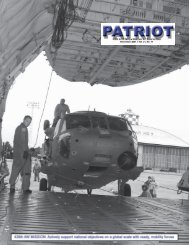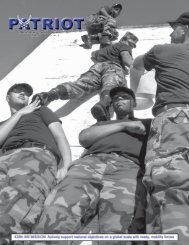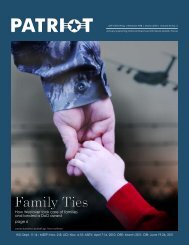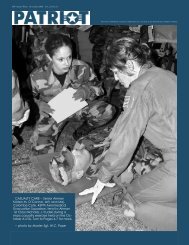Rebuilding A Nation - Westover Air Reserve Base, Mass
Rebuilding A Nation - Westover Air Reserve Base, Mass
Rebuilding A Nation - Westover Air Reserve Base, Mass
Create successful ePaper yourself
Turn your PDF publications into a flip-book with our unique Google optimized e-Paper software.
PATRIOT | JUNE<br />
TOP TACTICIAN >> Lt. Col. Douglas R. Gernhard trains all 337th <strong>Air</strong>lift Squadron aircrews on tactics procedures to better ensure their survivability<br />
during wartime missions. Colonel Gernhard is the <strong>Air</strong> Force <strong>Reserve</strong> Command Tactician of the Year. ( photo by Senior <strong>Air</strong>man Michael Lanza )<br />
Patriot Wing C-5 pilot wins<br />
AFRC Tactician of the Year<br />
by Tech. Sgt. Andrew Biscoe<br />
A Patriot Wing C-5 instructor pilot<br />
has earned command-wide honors for<br />
his efforts in teaching his fellow aviators<br />
combat tactics.<br />
Lt. Col. Douglas R. Gernhard, 337th<br />
<strong>Air</strong>lift Squadron chief of tactics, is the<br />
<strong>Air</strong> Force <strong>Reserve</strong> Command Tactician<br />
of the Year. The colonel’s tactics program<br />
teaches pilots how to operate the<br />
<strong>Air</strong> Force’s largest aircraft in some of the<br />
world’s most dangerous regions.<br />
His award package came out on top<br />
of candidates who fly combat aircraft<br />
-- such as F-16 and F-15 fighters.<br />
Colonel Gernhard’s selection for<br />
the award came as no surprise to Col.<br />
Udo K. McGregor, 439th Operations<br />
Group commander.<br />
“He was put in for the award because<br />
of his <strong>Air</strong> Mobility Command (AMC)<br />
benchmark tactics program. No other<br />
unit built and executed their tactics<br />
training as well as <strong>Westover</strong>, largely due<br />
to Doug’s extensive planning,” Colonel<br />
McGregor said. “It might seem a bit unusual<br />
that a C-5 unit would garner this<br />
award, but Doug’s bomber background<br />
in Strategic <strong>Air</strong> Command, his ability<br />
to plan deeply and execute completely,<br />
and the overall excellence of the training<br />
he developed which allowed us to operate<br />
more safely in the combat theater,<br />
made him an obvious choice.”<br />
In addition to having flown the B-52<br />
in the last years of the Strategic <strong>Air</strong><br />
Command at Loring <strong>Air</strong> Force <strong>Base</strong>,<br />
Maine, Colonel Gernhard has more<br />
than 3,500 hours in the C-5 cockpit.<br />
If there’s a C-5 lumbering over the<br />
base during a training flight, quite<br />
often it will be Colonel Gernhard at the<br />
controls, training another 337th <strong>Air</strong>lift<br />
Squadron pilot. He supervises many of<br />
the local flights teaching pilots the craft<br />
of flying the Galaxy in steep banks and<br />
turns as part of tactics procedures used<br />
when flying into and out of Iraq.<br />
“Tactics allow aircrews to exploit<br />
our enemies’ weaknesses -- and our<br />
strengths,” the colonel said.<br />
He has trained 60 pilots since 2004.<br />
Before the Sept. 11, 2001 terrorist attacks,<br />
AMC flights had become fairly<br />
routine for C-5 aircrews. “We were<br />
only using instrument flying, which<br />
meant standard approach and departure<br />
procedures, similar to how airline<br />
pilots fly,” Colonel Gernhard said.<br />
After Sept. 11, that began to change.<br />
By the time Operation Iraqi Freedom<br />
began in the spring of 2003, C-5s were<br />
periodically flying into Iraq. But when<br />
shoulder-fired missiles hit a C-5, a C-17<br />
and an A-300 <strong>Air</strong>bus, AMC leadership<br />
took a close look at the threats that<br />
faced these aircrews. Lt. Gen. Roger<br />
Brady, then the AMC director of operations,<br />
directed that the <strong>Air</strong> Force<br />
find a way for the aircrews to fly tactical<br />
approaches and departures, Colonel<br />
Gernhard said.<br />
In April 2004, then-Major Gernhard<br />
flew to Balad <strong>Air</strong> <strong>Base</strong>, Iraq, and<br />
worked with air traffic control specialists,<br />
airspace coordination personnel, and<br />
intelligence, bringing his tactics training<br />
plan back home. Since that time, he<br />
and a cadre of other senior officers have<br />
become qualified on flying tactics. Colonel<br />
Gernhard said it isn’t just the pilots<br />
that get the training. All of the aircrew<br />
members are trained before flying missions<br />
into Baghdad and Balad.<br />
“I modeled our training and airspace<br />
on the environment downrange and<br />
replicated it here,” said Colonel Gernhard.<br />
He also coordinated with and<br />
with the <strong>Westover</strong> tower staff. “We<br />
built the program from the ground up<br />
teaching ourselves the maneuvers in<br />
the C-5 simulator first. We then moved<br />
into the aircraft certifying ourselves in<br />
the jet and began teaching the initial<br />
core of instructors.”<br />
Colonel Gernhard credited Federal<br />
Aviation Administration and <strong>Westover</strong><br />
people for their help. He coordinated<br />
the new flying operations with Gary<br />
Fisk, a Bradley International <strong>Air</strong>port<br />
(Connecticut) air traffic controller.<br />
Additionally, Senior Master Sgt. Larry<br />
Milliken and the <strong>Westover</strong> intel office<br />
staff help keep the program current by<br />
monitoring changing enemy tactics.<br />
The AMC Inspector General recognized<br />
Colonel Gernhard’s tactics<br />
program during the 2006 ORI and<br />
distributed his program across<br />
AFRC and AMC as well, Colonel<br />
McGregor said.


